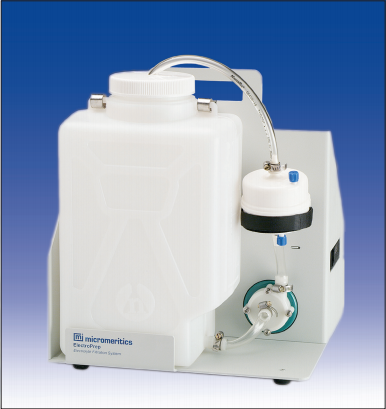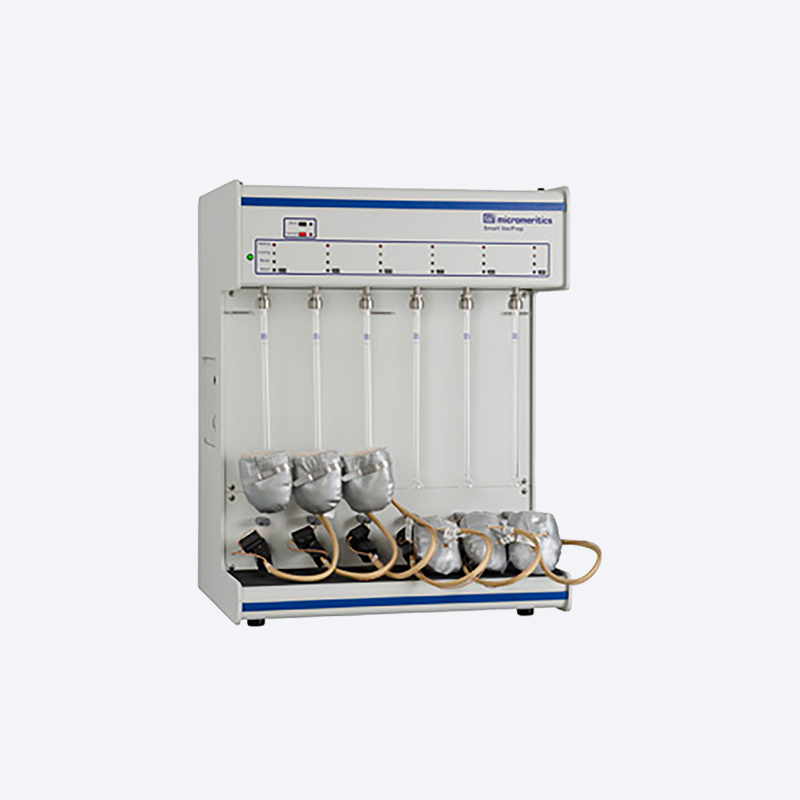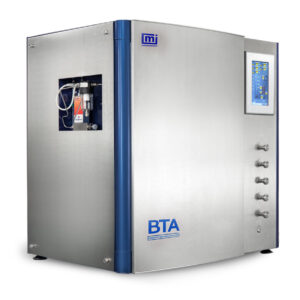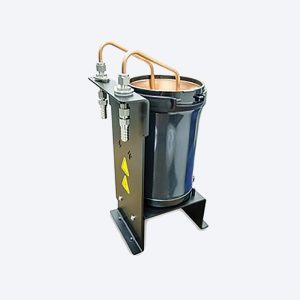Description
The quality of the data produced by surface area and pore volume analyses depends greatly on the cleanliness of the sample surface. All Micromeritics’ sample preparation devices accept helium, nitrogen, argon, and other non-corrosive gases.
The Smart VacPrep 067
The Smart VacPrep is an advanced six-port system that utilizes vacuum to prepare samples by heating and evacuation. Each of the ports may be operated independently. Samples may be added or removed from degas ports without disturbing the treatment of other samples undergoing preparation. Degassing automatically terminates when the samples have completed all programmed steps.
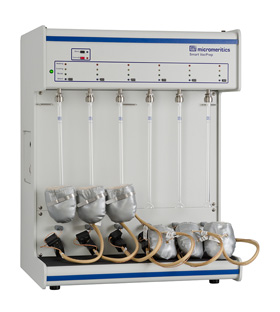
The SmartPrep 065
The SmartPrep™ 065 is a flowing-gas degassing unit which removes adsorbed contaminants from the surface and pores of a sample in preparation for analysis. It contains six sample ports, each one independently temperature-controlled for greater flexibility. It contains two serial ports, one for connecting to the computer and the other available for connection of an additional SmartPrep. The temperature, ramp rates, and soak times of each sample are individually controlled by the computer. Up to five ramps and soaks are allowed. All degas information is integrated into the sample data file for future reference.
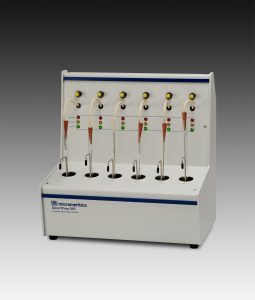
The VacPrep 061
The VacPrep™ 061 offers two methods for removing contaminants. In addition to flowing gas, it provides vacuum to prepare samples by heating and evacuation. This combination allows you to choose the preparation method that is best suited to your material or application. The VacPrep features six degassing stations, and a choice of vacuum or gas flow preparation on each of the six stations. Needle valves are also provided allowing you to introduce the flowing gas or vacuum slowly to prevent fluidization of samples.
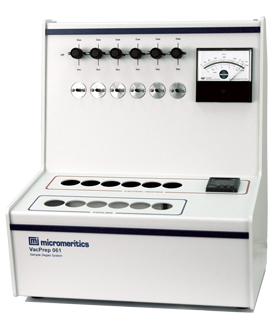
The FlowPrep 060
The FlowPrep™ 060 applies both heat and a stream of inert gas to the sample. The heat causes contaminants to desorb from the surface and the stream of inert gas sweeps them out of the sample tube. It lets you choose the temperature, gas, and flow rate best suited for your sample material and application. Needle valves allow you to introduce the flowing gas slowly to prevent fluidization of samples.
The MicroPrep
For use with the ASAP 2060, the MicroPrep allows in-situ final degassing of micropore samples to assure that the sample is meticulously cleaned of any adsorbed contaminants prior to analysis. The MicroPrep features a high-quality digital control unit to regulate the heating mantle to the desired set point temperature.
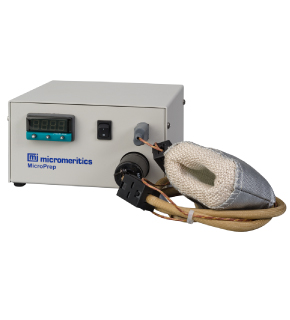
Specifications:
- Temp Range: Ambient to 250 °C
- Temp Accuracy: +/- 5.0 °C
- Ramp Rate: 10 °C
- Electrical: 100–240 VAC, 50-60Hz
The Model 021 LN2 Liquid Nitrogen Transfer System
The Model 021 LN2 Transfer System allows you to transfer liquid nitrogen or liquid argon from a nonpressurized storage Dewar into smaller containers as needed in laboratory experiments. The system was specifically developed for conveniently filling Dewars for gas adsorption instruments but also can be used for other cryogen applications. The Model 021 can discharge cryogens at adjustable rates up to 3 liters/min. The roller base makes it easy to move the 021 System to the location where the cryogen is needed. The nozzle and insulated, flexible hose enable convenient filling and refilling of analysis Dewars. The system can hold liquid nitrogen or argon up to 30 days allowing cost-efficient use of your cryogen.
MasterTech 052
The new MasterTech 052 Autosampler increases sample throughput, improves reproducibility, and requires less operator time for particle size analysis with the SediGraph or the Saturn DigiSizer. The MasterTech Autosampler increases throughput by ensuring there is no lapse between the completion of one analysis and the beginning of the next. Reduced operator involvement not only limits the possibility of human error, but saves time and increases repeatability and reproducibility. You can queue up to 18 samples to run sequentially and completely unattended. Operation of the MasterTech is controlled by the instrument’s operating software with dispersion and redispersion information automatically stored in the sample file for future reference. One computer can control two instruments, each with its own MasterTech automatic sample feeder.
The MasterTech features a powerful ultrasonic probe. Power to the probe tip is adjustable and the driving circuit is self-tuning for maintaining efficient and consistent sonic energy from the input power. A digital readout on the front panel assures that the desired power is reached for dispersing each sample and that the same power is applied each time the method is repeated.
During operation, the tray is loaded with up to 18 beakers, each containing approximately 80 mL. When required, the tray may be removed from the instrument by pressing the LOAD button on the front panel. This raises the arm assembly to allow removal or replacement of the tray. When the tray is in place, the LOAD button is again pressed to signal the computer that the tray is in position and automatic analysis may proceed.
When the instrument is ready to analyze a sample, the tray will rotate until the selected sample is underneath the arm assembly. The arm assembly will then lower and stirring will start. It continues until the sample is thoroughly re-suspended. At a predetermined time, the ultrasonic probe can be activated to aid in dispersion. Once re-dispersion is complete, the MasterTech’s built-in pump transfers the sample to the instrument where it is loaded into the mixing chamber. Analysis will now proceed automatically.
It is the same as if a human operator had filled the mixing chamber with predispersed sample. After the analysis is started, the MasterTech’s stirrer rotor, ultrasonic probe and transfer tubing are all back-flushed with clean liquid and made ready for the next analysis cycle. The arm will raise so that the rinse liquid will remove any sample remaining on the stirrer rotor and probe, and in the transfer tube. When analysis is complete, the contents of the mixing chamber are pumped to the waste container, and the MasterTech will automatically proceed to the next sample. The process will continue without the need for operator intervention until the particle analysis system has completed all requested analyses.
FEATURES / BENEFITS
- Unattended Operation
- Frees the operator to perform other tasks.
- Sample Capacity
- Allows up to 18 samples to be analyzed automatically.
- Non-Sequential Operation
- Operator can pre-program samples in any sequence.
- Ease of Operation
- Increases efficiency and throughput while decreasing the amount of operator intervention.
- Mechanical Stirrer/Ultrasonic Probe
- Provides automatic stirring action and redispersion of sample for a user-specified length of time.
- Back-flushing
- Prevents cross-contamination of sample by cleaning magnetic stirrer and sample-transfer tubing.
- Removable Tray (Carousel)
- Allows the operator to prepare samples on one tray while analyses on another tray are in progress.
- Dust Shield
- Prevents airborne particles from contaminating the sample.
- Easy Installation
- Connects to an already present connector on any SediGraph 5100. No modifications are required.
SPECIFICATIONS
- Sample Capacity:
18 per tray; continues indefinitely if tray is replenished - Sample Size:
0.5 to 4 g of powder in 60 to 80 mL of liquid - Sample Type:
Any suitable for SediGraph 5100 analysis - Suspending Liquid:
Any liquid compatible with sample cell materials and not highly absorptive of X-rays. Typical liquids are water, glycols, kerosene, mineral oils, alcohols, Sedisperse, and mineral spirits - Wetted Materials:
Glass, stainless steel, Viton®1, Tygon®2, Silicone rubber, Polypropylene - Voltage:
100, 120, 220 or 240 VAC +/- 10% - Current:
1.25 A (100/120 VAC); 0.75 A (220/240 VAC) - Power:
180 VA maximum - Frequency:
50/60 Hz - Temperature:
10 to 40 deg C operating; -10 to 55 deg C in storage or when shipped - Humidity:
20 to 80% relative (non-condensing) - Height:
68.6 cm (27 in.) maximum (at Load position) - Width:
45.7 cm (18 in.) - Depth:
53.3 cm (21 in.) - Weight:
18 kg (40 lbs) - Footnotes:
1 Viton® is a registered trademark of DuPont Dow Elastomers.
2 Tygon® is a registered trademark of Norton Company.
AquaPrep II – for Saturn DigiSizer II
Particle size measurement instruments typically employ deionized or even untreated water as a suspension medium for particle dispersion during analysis. Usually, this water contains undesirable levels of dissolved gases, most often those commonly present in the atmosphere. During analysis, these gases can come out of solution, forming minute bubbles that can have important effects on the analytical results. Regardless of the relative size of the bubbles, their presence distorts the reported distribution of sizes; it also degrades the repeatability of analyses.
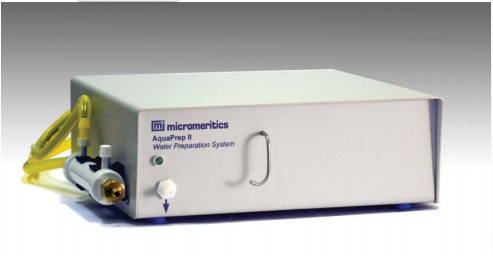
ElectroPrep 053
The Micromeritics ElectroPrep is a highly effective system for the preparation of contaminant- free electrolyte for use with the Elzone II and other instruments. If you are looking for an easy-to-use electrolyte filtering device to ensure high-quality particle size data, then Micromeritics’ new ElectroPrep 053 is a necessary addition to your laboratory.
